Solutions to increase the probability of the accuracy of UAV recognition target based on artificial intelligence
525 viewsDOI:
https://doi.org/10.54939/1859-1043.j.mst.FEE.2023.105-110Keywords:
UAV; Residual; Loss function; Radar target recognition; Deep learning.Abstract
In this article, we propose to build a neural network model with a combined Residual-Inception structure (named RINet) and use the weighted Focal Loss loss during training to perform radar target classification based on the RAD-DAR dataset. The RINet model incorporating the proposed loss function has an average target classification accuracy of 98.72%, in which the probability of correctly identifying the UAV is up to 99.81%.
References
[1]. Research, G.V. “Commercial UAV Market Analysis By Product”, (FixedWing, Rotary Blade, Nano, Hybrid), By Application (Agriculture, Energy, Government, Media and Entertainment) In addition, Segment Forecasts to 2022. 2016. Available online: https://www.grandviewresearch.com/industry-analysis/commercialuavmarket (accessed on 24 April 2019)
[2]. X. Shi, C. Yang, W. Xie, C. Liang, Z. Shi, J. Chen, “Anti-drone system with multiple surveillance technologies: Architecture, implementation, and challenges”, IEEE Commun. Mag. 56, 68–74, (2018). DOI: https://doi.org/10.1109/MCOM.2018.1700430
[3]. B. Torvik, K. E. Olsen, and H. Griffiths,“Classification of birds and UAVs based on radar polarimetry”, IEEE Geoscience and Remote Sensing Letters, vol.13, no.9, pp.1305-1309, (2016). DOI: https://doi.org/10.1109/LGRS.2016.2582538
[4]. P. Zhang, L. Yang, G. Chen and G. Li, “Classification of drones based on micro-Doppler signatures with dual-band radar sensors”, inProc. 2017 Progress in Electromagnetics Research Symposium - Fall (PIERS - FALL), Singapore, pp. 638–643, (2017). DOI: https://doi.org/10.1109/PIERS-FALL.2017.8293214
[5]. I. Roldan, C.R. del Blanco, A. Duque de Quevedo, F. Ibañez Urzaiz, J. Gismero Menoyo, A. Asensio López, D. Berjón, F. Jaureguizar, N. García, “Dopplernet: a convolutional neural network for recognising targets in real scenarios using a persistent range–Doppler radar”, IET Radar Sonar Navig. 14 (4), 593–600, (2020). DOI: https://doi.org/10.1049/iet-rsn.2019.0307
[6]. Tsung-Yi Lin Pri “Focal Loss for Dense Object Detection” arXiv:1708.02002.
[7]. Ann Janeth Garcia, Ali Aouto, Jae-Min Lee, Dong-Seong Kim “CNN-32DC: An improved radar-based Drone recognition system based on Convolutional Neural Network”, ScienceDirect accepted (2022). DOI: https://doi.org/10.1016/j.icte.2022.04.012
[8]. Christian Szegedy, Wei Liu, Yangqing Jia, Pierre Sermanet, Scott Reed, Dragomir Anguelov, Dumitru Erhan, Vincent Vanhoucke, Andrew Rabinovich. “Going Deeper With Convolutions” Proceedings of the IEEE Conference on Computer Vision and Pattern Recognition (CVPR), pp. 1-9, (2015). DOI: https://doi.org/10.1109/CVPR.2015.7298594
[9]. Kaiming He, Xiangyu Zhang, Shaoqing Ren, Jian Sun “Deep Residual Learning for Image Recognition” Proceedings of the IEEE Conference on Computer Vision and Pattern Recognition (CVPR), pp. 770-778, (2016).
[10]. Muhammad, W.; Bhutto, Z.; Ansari, A.; Memon, M.L.; Kumar, R.; Hussain, A.; Shah, S.A.R.; haheem, I.; Ali, S. “Multi-Path Deep CNN with Residual Inception Network for Single Image Super-Resolution”. Electronics, 10, 1979, (2021). https:// doi.org/10.3390/electronics10161979 DOI: https://doi.org/10.3390/electronics10161979







